Previously on seam-along ...
Introduction
Week 1 - simple edge finishes
This week I took a look at French seams, which are durable and quite straight forward to construct. They also look beautiful.
French seam
This is a lovely, enclosed seam - essentially a seam-within-a-seam. Due to its construction, it is really only suited to straight edges. You start by putting the wrong sides of the fabric together. Then using only a small seam allowance (say 1/4"), you machine stitch the seam.

Trim away some of the excess seam allowance and press the seam to one side.

Flip the fabric so that the right sides are together and the seam is enclosed. And stitch again.

Next, push the new enclosed seam to one side and press.
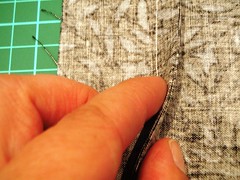
Et voila - you have your French seam. I read somewhere that in France this finish is known as an English seam. I have no idea whether this is true or not, but it makes a good story.
Mock French seam
This faux French seam finish can be used on curves. This time you put the right sides of the fabric together and stitch on the regular seam line.
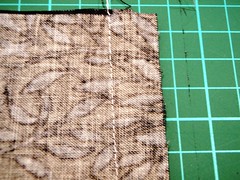
Open the seam out flat.
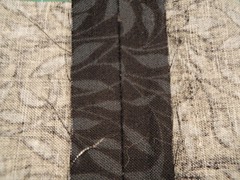
Turn each of the raw edges inward ...
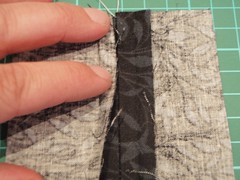
.... and press.
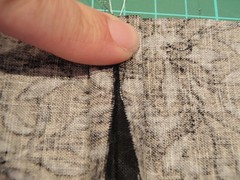
Bring both sides of the folded seam allowance together.

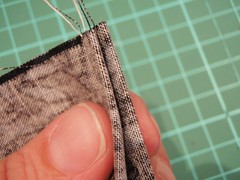
Top stitch in place.

Press the whole seam to one side.

Conclusion
To be honest I'm quite smitten with both these finishes. And just quietly, I have a message for my overlocker: Get your act together you recalitrant piece of machinery and loop and stitch as you should or it will be more than a French fling.
Did you seam-along this week? When would you use French seams?
Next Wednesday: Stay tuned next week, when bound seams (including a Hong Kong finish and a bit of gratuitous ditch stitching) will be on show. Read more about bound seams via Google.






I'm still having a hard time following the real french seam. I don't get the flipping the fabric together and over and etc!!! I'll have to practice this tonight to fully comprehend the instructions.
ReplyDeleteHey HB - I am loving your seam instructions, thank you for taking the time and effort. I have one of those great big how to sew books but your instructions are much easier!
ReplyDeleteJust a question (it might help Natasha above as well) - with your french seam, your first instruction says put wrong sides together but your first picture is of right sides together ??
Looking forward to more - keep this coming
Oh rats! It would help if I had actually posted the right picture for the first step of the French seam. Sorry Natasha and EB! I have edited it to show the correct one. Hopefully this will work a bit better ....
ReplyDeleteI'm loving this seam along. Really fabulous.
ReplyDeleteHurrah for the seam-a-long. I use French seams quite a bit. I made a four panel wrap skirt (made with straight edges) and I french seam those. I also french seam when I'm doing unlined pencil cases.
ReplyDeleteThanks for showing us all the great finishes!
I love French seams with a passion. They are they best. You are doing such a beautiful job of illustrating different seam finishes!
ReplyDeleteMakes so much more sense! I'll have to try this before the week is over!
ReplyDeleteI've heard people talk about French seams but never known how to do them, now I will definitely have a go - they create such a neat finish.
ReplyDeleteThanks for doing this seam-along, I'll definitely be checking out next week's post.
Oh, I have always wanted to do a French seam - read about it once, but haven't tried it yet. Perhaps that panel skirt will soon get made?!
ReplyDeletethank you ! I never knew about the mock French seam, so excited! I use French seams for every tote that I don't line.
ReplyDeletethank you so much! I have a shopping bag project that I've been avoiding because of the french seams but now I'm going to give it a go. I think I would use this also for summer skirts that I wouldn't want to line
ReplyDeleteThanks for this! Finally I won't have to line everything to hide my horrific seams!
ReplyDeletethanks so much for the reminder of beautiful french seams. Now I remember why I loved them so
ReplyDeleteGreat seam-along Liesl. I love french seams - I use them for anything sheer or semi-sheer, and just when I want things to look extra-nice on the inside (and when I'm not feeling lazy).
ReplyDeletehello, i'm french, and that's true.. we call these seams english seams !!
ReplyDeleteOooh, thanks for sharing how to do a real french seam! I have a serger which is very tempermental so I rarely use it instead opting for the 'mock' french seam you showed to finish off my garments but now I'm going to have to try the other way! Can't wait to see next week's tutorial :)
ReplyDeleteHmmm been having some trouble leaving comments >.<
ReplyDeleteFrench seams are one of my favourites! Although I have to concentrate really hard because of the flipping back and forth. And if you bugger it up it's an absolute pain to unstitch. I have never tried the second method, will have to give it a go.
thanks for the inspiration!
ReplyDeleteI just used a modified version of your french seam on the sides of boxers for my teenage son. since I found it a bit tidious to fold the seam allowance sort of "against each other" like you do, I just folded both of them together to the same side an then stiched. seemed easier...
Thanks for posting! I think I will try this on a simple grocery tote, since usually they are unlined. I'll let you know how it goes...wish me luck!
ReplyDeleteLovin the seam lessons! This one is great, I'll be using it a lot from now on. Thanks!
ReplyDeleteThank you for this very clear explanation! I'm guessing you need to cut your fabric slightly larger (or make your seam allowance smaller) to account for the fact that you are essentially sewing the seam twice. Would you say that's true?
ReplyDeleteI was in one of my neighbors' house and I saw these beautiful French seams and I said in my mind...I want those French seams in my house too, so I researched for them on Google and I got to your blog! thanks!
ReplyDeleteI like that French seams. Its really looks fabulous. Thanks for share it.
ReplyDeleteHey really very interesting information about "French Seams"..... I like your blog very much.... Thanks very much for sharing this information here.
ReplyDeleteAwesome photos..
ReplyDeleteThanks a lot for this nice information the way of giving the information is very nice step by step. Thanks a lot once again.
ReplyDeleteSmith ALan
Hi,
ReplyDeleteReally This is an amazing information about "French seam" Thanks very much for sharing it.
Thanks!
I like this french seam..Nice work done..I definitely try to make this pattern.Thanks for sharing!!
ReplyDeleteHello,
ReplyDeleteThis is an amazing blog post found here.... Keep posting such an awesome blog post.
Thanks!
hello,
ReplyDeleteThis is an interesting tutorial found here.... Very interesting. Thanks very much for the share....
This has been a very significant blog indeed. I’ve acquired a lot of helpful information from your article. Thank you for sharing such relevant topic with us. I really love all the great stuff you provide. Thanks again and keep it coming.
ReplyDeleteThanks for informative and helpful post, obviously in your blog everything is good.If you post informative comments on blogs there is always the chance that actual humans will click through.
ReplyDeletethanks you so much for sharing this! i love your blog and will definitely bookmark this
This comment has been removed by a blog administrator.
ReplyDeleteThis comment has been removed by a blog administrator.
ReplyDeleteThis comment has been removed by a blog administrator.
ReplyDeleteThis comment has been removed by a blog administrator.
ReplyDeleteThis comment has been removed by a blog administrator.
ReplyDeleteThis comment has been removed by a blog administrator.
ReplyDeleteHello,
ReplyDeleteI found this post very interesting. This blog always have amazing post and it is very useful for everyone. I have acquired a lot of helpful information from your article. Thank you for sharing such relevant topic with us. I really liked the great information you have provide.